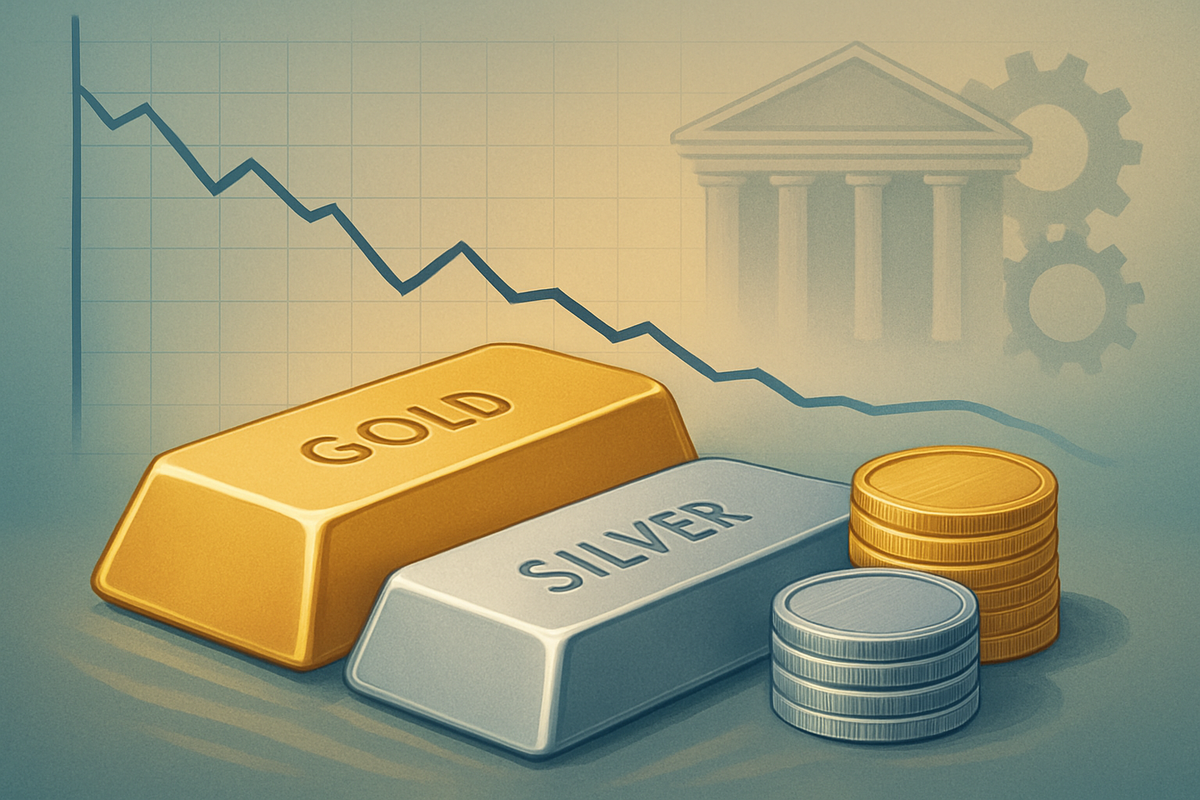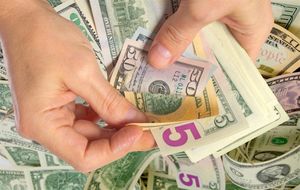
Gold and silver prices have recently experienced a significant, yet widely anticipated, "healthy correction" following an extraordinary rally throughout 2025. This tactical retreat in precious metals, which saw gold (XAU) momentarily dip from an astonishing $4,398 per ounce and silver (XAG) from its new all-time high of $55.51 per ounce, is occurring as markets brace for a crucial Federal Reserve policy meeting scheduled for October 28-29, 2025. This correction, driven by profit-booking, a strengthening U.S. dollar, and easing global tensions, is seen by many analysts as a necessary consolidation phase, allowing the market to rebalance before potentially resuming its upward trajectory.
The immediate implications of this price adjustment are profound, as investors weigh the likelihood of a widely expected 25-basis-point interest rate cut by the Federal Reserve. While the market has largely priced in this move, the Fed's forward guidance and any hints regarding future monetary policy will be pivotal in shaping the near-term direction of gold and silver. The current sentiment reflects a cautious optimism, with many long-term investors viewing these dips as strategic entry points, reinforcing the underlying bullish conviction for precious metals in an environment of anticipated lower real interest rates and persistent geopolitical uncertainties.
Precious Metals Take a Breather Amidst Market Rebalancing
The recent price action in gold and silver marks a significant moment in their 2025 performance, which has been characterized by an impressive bull run. Gold had climbed 58% and silver a staggering 69% year-to-date before their recent peaks. On October 20, 2025, gold touched $4,398 per ounce, and silver soared to $55.51 per ounce, setting new nominal all-time highs. However, this remarkable ascent led to overbought conditions, making a correction inevitable. The downturn began sharply on October 21-22, 2025, with gold experiencing its largest single-day percentage decline in over a decade, plummeting more than 6%. Silver suffered an even steeper drop, shedding nearly 10% in a single day.
This correction was primarily triggered by a confluence of factors. A wave of profit-booking ensued as investors capitalized on months of consistent gains. Simultaneously, a strengthening U.S. dollar made dollar-denominated commodities less attractive for international buyers. Furthermore, a perceived reduction in geopolitical uncertainties, including optimism surrounding potential trade agreements between the U.S. and China, lessened the immediate safe-haven demand that often propels precious metals during times of global instability. Despite these declines, as of October 23-24, 2025, both metals showed signs of rebound due to "bargain buying" and "value buying," indicating that many investors view these lower prices as attractive opportunities. For instance, MCX gold futures for December delivery declined to ₹1,22,995 per 10 grams, while silver futures dropped to ₹1,45,829 per kg, but still maintained significant year-to-date gains.
Key players in this market dynamic include central banks, particularly the Federal Reserve, whose monetary policy decisions are paramount. Major precious metals dealers, institutional investors, and retail traders are also significant stakeholders, influencing price movements through their buying and selling activities. The initial market reaction to the correction has been a mix of caution and strategic accumulation. While some short-term traders have exited positions, long-term investors and exchange-traded fund (ETF) holders have largely maintained their exposure, with gold ETF holdings notably near a three-year high, signaling robust underlying confidence.
The timeline leading up to this moment began with sustained inflationary pressures and geopolitical tensions throughout late 2024 and early 2025, which fueled the initial rally in precious metals. The expectation of an eventual dovish pivot by the Federal Reserve, driven by slowing economic growth and the need to support liquidity, further bolstered sentiment. The current correction, therefore, represents a natural technical adjustment within this broader bullish narrative, rather than a fundamental shift. It provides a crucial "breather" for the market, allowing it to consolidate gains and prepare for the next phase, which will heavily depend on the outcomes of the impending Fed meeting.
Companies Navigating the Volatility: Winners and Losers
The recent "healthy correction" in gold and silver prices, coupled with the anticipation of a Federal Reserve meeting, presents a mixed bag for public companies operating within the precious metals sector. While a temporary price dip might seem detrimental, it often creates strategic opportunities for some, while posing short-term challenges for others.
Potential Winners:
Companies with strong balance sheets and low production costs are best positioned to weather the current volatility and potentially capitalize on future price appreciation.
- Major Gold Miners: Large-cap gold mining companies such as Barrick Gold Corp. (NYSE: GOLD) and Newmont Corporation (NYSE: NEM) often benefit from price corrections if they have managed to maintain healthy profit margins during the preceding rally. A dip can allow them to acquire smaller, distressed assets at more favorable valuations, consolidate their market position, and optimize their cost structures. If the Fed's dovish stance leads to sustained higher gold prices post-correction, these companies will see significant revenue and profit boosts.
- Silver Producers: Similarly, established silver miners like Pan American Silver Corp. (NASDAQ: PAAS) and Wheaton Precious Metals Corp. (NYSE: WPM), which also often have diversified portfolios including gold and other base metals, can leverage strong operational efficiency. The current correction offers an opportunity for these companies to potentially increase reserves through exploration or strategic acquisitions if smaller players struggle.
- Precious Metals ETFs and Funds: While the immediate NAV (Net Asset Value) of ETFs like SPDR Gold Shares (NYSE Arca: GLD) and iShares Silver Trust (NYSE Arca: SLV) will reflect the price correction, the underlying funds often see increased investor interest during such dips. Long-term investors may view these lower prices as opportune entry points, leading to inflows into these ETFs, ultimately benefiting the fund managers and potentially driving future price recovery.
- Refiners and Dealers: Companies involved in the refining, fabrication, and dealing of physical gold and silver, such as Johnson Matthey PLC (LSE: JMAT) (though diversified, with a significant precious metals division), might experience a temporary slowdown in demand during sharp price drops. However, increased market activity, including both selling during peaks and buying during dips, can boost their transaction volumes and hedging activities, creating revenue opportunities.
Potential Losers:
Companies with high debt, inefficient operations, or heavy reliance on short-term market sentiment could face headwinds.
- Junior Miners and Explorers: Smaller, exploration-focused companies often lack the financial resilience to withstand significant price corrections. Their projects are typically more sensitive to commodity price fluctuations, and a sustained dip can make it harder to secure financing for exploration and development, potentially leading to project delays or even abandonment.
- Leveraged Speculators: Individual investors or funds with highly leveraged positions in gold and silver futures or options can face margin calls and substantial losses during sharp corrections, leading to forced selling that can exacerbate downward price pressure.
- High-Cost Producers: Mining companies with higher-than-average production costs per ounce of gold or silver will see their profit margins squeezed considerably during a price correction. This could lead to reduced profitability, operational reviews, and potential mine closures if prices remain depressed for an extended period, though this "healthy correction" is expected to be short-lived.
Ultimately, the impact on these companies will hinge on the duration and depth of the correction, as well as the Federal Reserve's guidance. A quick rebound, fueled by a dovish Fed, would likely see the "winners" quickly recover and thrive, while a more prolonged downturn could test the resilience of the more vulnerable players.
Broader Significance: A Return to Fundamentals
The recent "healthy correction" in gold and silver prices, preceding an anticipated Federal Reserve rate cut, holds broader significance for the financial markets, signaling a potential return to more fundamental drivers after a period of intense speculative fervor. This event fits squarely into the broader industry trend of market consolidation after significant rallies, particularly in assets that have benefited from safe-haven demand and inflationary hedges. The rapid ascent of gold and silver throughout 2025, driven by geopolitical tensions and persistent inflation concerns, had pushed both metals into overbought territory, making a technical correction a statistical inevitability rather than a surprise.
The potential ripple effects extend beyond the precious metals sector. A strengthening U.S. dollar, which contributed to the recent dip, can put pressure on other dollar-denominated commodities, including oil and industrial metals. Conversely, if the Fed's rate cut signals a broader shift towards looser monetary policy globally, it could weaken the dollar in the long run, thereby providing a tailwind for commodities. Competitors in the investment landscape, such as equity markets, might see increased inflows if the easing of geopolitical tensions and a stable interest rate environment encourage a shift back to riskier assets, temporarily diverting capital from precious metals. Partners in the mining and refining industries, including equipment suppliers and logistics providers, will closely watch price stability, as it directly impacts investment decisions by mining companies.
Regulatory and policy implications are also at play. The Federal Reserve's actions are central, as a rate cut directly impacts the opportunity cost of holding non-yielding assets like gold. A sustained period of low real interest rates, a likely outcome of continued dovish policy, would be a strong fundamental support for precious metals. Furthermore, any shifts in global trade policies or sanctions, such as the ongoing U.S. sanctions on Russia, continue to influence safe-haven demand and supply chains for precious metals. Governments and central banks, as significant holders of gold, also play a role through their reserve management strategies, which can influence market sentiment.
Historically, such corrections are common during extended bull markets. For instance, during the gold bull market of the 2000s, there were several corrections of 10-15% that ultimately proved to be temporary pauses before further advances. Similarly, silver has a history of more volatile but equally resilient corrections. These historical precedents suggest that the current dip is part of a natural market cycle, allowing for a re-evaluation of valuations and a re-establishment of sustainable support levels. The key difference now is the unprecedented level of global debt and the unique geopolitical landscape, which could amplify or mitigate the effects of traditional market cycles, making the Fed's guidance even more critical.
The Road Ahead: Navigating Post-Fed Market Dynamics
As markets digest the recent corrections in gold and silver, all eyes are firmly fixed on the upcoming Federal Reserve meeting, which will largely dictate the short-term and long-term possibilities for precious metals. In the short-term, if the Fed delivers the anticipated 25-basis-point rate cut and signals a dovish outlook for future monetary policy, gold and silver are likely to experience a rebound. Lower interest rates reduce the opportunity cost of holding non-yielding assets, making them more attractive. However, if the Fed's statement is more hawkish than expected, hinting at limited future cuts or expressing concerns about inflation, precious metals could face further downward pressure, at least temporarily.
In the long-term, the outlook remains largely bullish for gold and silver, especially if the global economic environment continues to be characterized by persistent inflation, geopolitical instability, and a devaluing U.S. dollar due to expansive fiscal and monetary policies. These factors provide strong fundamental support for precious metals as hedges against uncertainty and inflation. Potential strategic pivots for investors would involve maintaining a core allocation to precious metals, using any further dips as opportunities to accumulate, and diversifying across physical metal, ETFs, and robust mining equities.
Market opportunities that may emerge include renewed interest from institutional investors seeking portfolio diversification and inflation protection. The current correction, by reducing overbought conditions, could attract new capital that was previously hesitant to enter at peak prices. Challenges, however, include the ongoing strength of the U.S. dollar, which could cap upside potential, and the risk of unexpected shifts in global economic data or geopolitical events that could alter market sentiment rapidly. Another challenge is the potential for increased regulatory scrutiny on commodity markets if volatility persists, although this is less likely to be a direct outcome of the current situation.
Potential scenarios and outcomes range from a swift recovery and continuation of the bull market, driven by a dovish Fed and persistent global uncertainties, to a more prolonged consolidation phase if economic data improves significantly and reduces the urgency for further rate cuts. A "black swan" event, such as a major escalation of geopolitical conflict or a severe economic downturn, could also rapidly accelerate safe-haven demand for gold and silver, pushing prices to new highs regardless of immediate Fed actions. Conversely, a significant de-escalation of global tensions and a strong, stable economic recovery could temper some of the bullish enthusiasm.
Wrap-Up: A Resilient Market Poised for the Next Chapter
The recent "healthy correction" in gold and silver prices, prior to the Federal Reserve's pivotal meeting, serves as a crucial rebalancing act within what has been a robust bull market for precious metals in 2025. The key takeaway is that this dip, while sharp, appears to be a technical adjustment rather than a fundamental reversal. It has been driven by natural market forces such as profit-booking and a stronger dollar, alongside easing, albeit temporary, geopolitical tensions. The market's anticipation of a 25-basis-point rate cut by the Fed has been largely priced in, but the true impact will hinge on the central bank's forward guidance.
Moving forward, the market for gold and silver is assessed to be resilient, with a strong underlying bullish sentiment. The extraordinary year-to-date gains of 60% for gold and 67% for silver, even after the correction, underscore the robust demand and investor confidence in these assets as stores of value. The current consolidation phase provides a healthier foundation for future growth, reducing the risk of an overheated market. Investors should watch closely for the Federal Reserve's official statement and Chairman Powell's press conference for clues on the trajectory of interest rates and the Fed's economic outlook. Any indication of further dovishness or concerns about economic growth and inflation would likely provide a significant boost to precious metals.
The lasting impact of this event will likely be seen as a reaffirmation of the cyclical nature of commodity markets and the importance of technical corrections in sustaining long-term trends. It highlights the interplay between monetary policy, geopolitical events, and investor sentiment in shaping asset prices. What investors should watch for in the coming months includes not only the Fed's subsequent meetings and inflation data but also global geopolitical developments and the performance of the U.S. dollar. These factors will be instrumental in determining whether gold and silver resume their upward climb or enter a more extended period of consolidation. The smart money will likely view any further dips as opportunities to fortify their positions in these historically reliable safe-haven assets.
This content is intended for informational purposes only and is not financial advice





